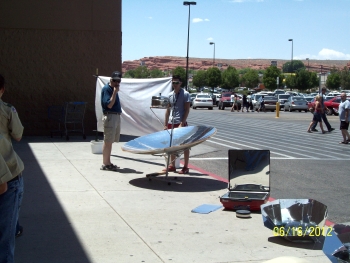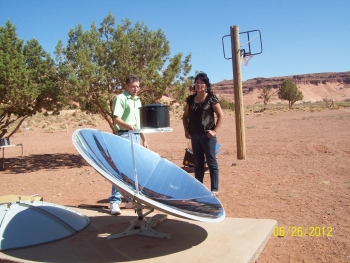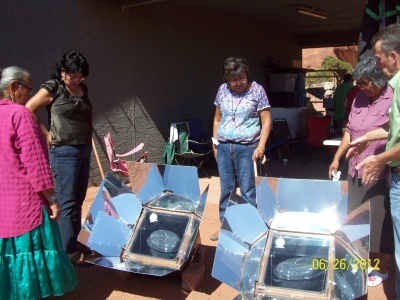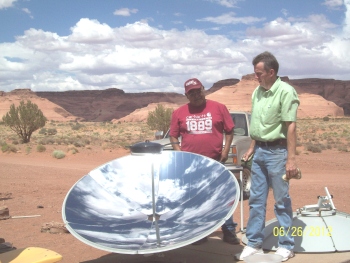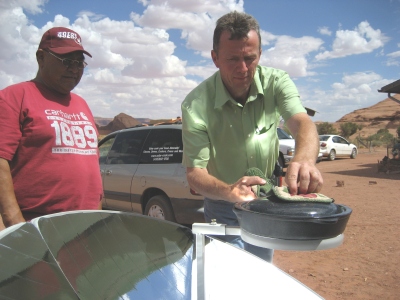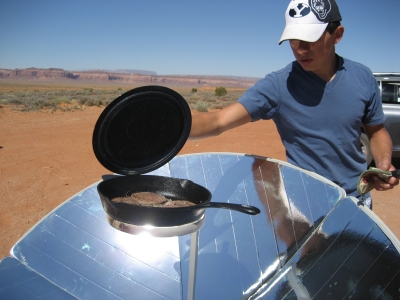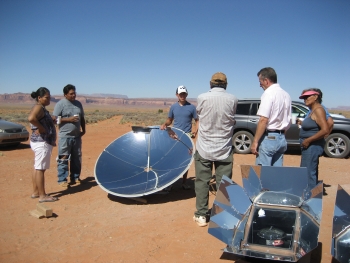Navajo Reservation Solar Cooking
The Navajo Reservation Solar Cooking Project for Summer of 2012 was a great experience that permitted us to help people with a real need for alternative means of cooking their everyday meals.
Joshua Parry's Navajo Reservation Eagle Scout Solar Cooker Project
This whole project idea came about in March of this year, 2012, when my Son, Joshua, and I were discussing something we might do for his Eagle Scout Project, something different, as well as beneficial and impactful.
Of course since the both of us have much interest in Solar Cooking, and are daily users of solar cookers, we felt that this would be an area of expertise that we might use to benefit others in a lasting and meaningful way.
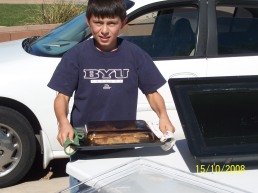
Joshua when he was 12 holding a pan with solar cooked Salmon
We thought that it might be nice to be able to help a people who had a
real need for alternative forms of cooking that would help them save on
the cost of expendable fuels, similar to the same need of people in poor
third world countries.
We have always been interested in going
to a third world country with our solar cookers, in order to be able to
help the desperately poor, but it has never really been a feasible
possibility for us due to the cost and logistics of doing such a
venture.
So, for some time we have been looking within our own
community and our own country for a similar need and realized there are
those right here amongst us who have similar challenges with regards to
earning a living and having sufficient food, fuel and sustenance.
In the past I had worked with an organization based in Park City, Utah called; Adopt-a-Native Elder, and when they contacted me this year about doing a Navajo Reservation solar cooking project with them, I immediately asked them if my son could work his Eagle Scout Project into the program.
They
said that would be great and asked us if we would raise money for food
boxes and extra solar cookers (parabolic) that could be given to the
families we would be working with, and so we agreed.
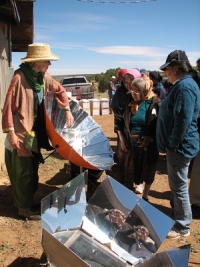
Patricia McArdle demonstrating her "SunBrella" Solar Cooker on the Navajo Reservation in 2010
Adopt-A-Native-Elder was receiving funding for this particular phase of the Reservation Project from American Express Inc. which had already designated money for three families, or recipients, to receive two Global Sun Ovens
and accessories each, and the food to cook two meals for each family
each day. The idea behind this solar cooker project was to educate and
teach with hands on experience, the concepts of solar cooking and the
ability it provides for the individuals/families to cook without the use
of expendable and costly fuels such as wood, propane or charcoal.
Our
part of the project included setting in motion my son Joshua's Eagle
Scout Project by getting the approval of the Eagle Board and then
organizing a fund raiser using the scouts within his troop to organize
and execute the fundraiser, all within a short period of time before we
were scheduled to go to the Monument Valley Navajo Reservation from June 24th through the 28th.
After gaining quick and willing approval from one of the local Walmart, the Fundraiser was held at the local Walmart parking lot in Washington, Utah
where we put on a solar cooking demonstration with solar cooked samples
and goodies given out to the public while soliciting donations for the
Eagle Scout Project. The event ended up being very successful and almost
$600.00 was raised in a short time.
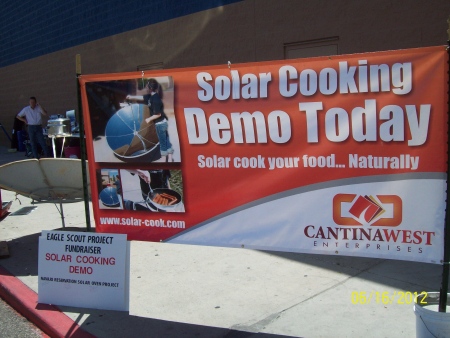
Setup in front of Walmart in St. George, Utah for the Fundraising and cooking demonstration
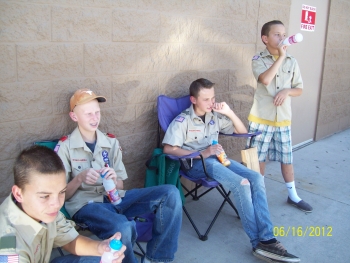
Several of the Scouts assisting us in our fundraiser
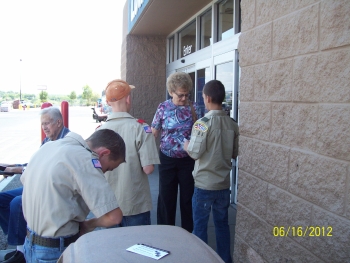
Receiving donations for the Eagle Scout Solar Cooker Project from passersby
One of my sons showing the Solar Burner Parabolic to an onlooker
At the same time we had several people donate through our website as
well as a handful of donations that were given us by participants in a
local golf tournament/charity fundraiser that we were invited to set up
our solar cookers at. We were able to raise a total of $850.00 with
$270.00 used for the food boxes for each family and the rest to provide
four Solar Burner Parabolic Cookers to compliment the six Global Sun Ovens.
The
original intent was to give two Global Sun Ovens with
cookware/accessories to each of the three families along with a
parabolic cooker so that they had sufficient capacity to cook several
foods/dishes at a time.
In the end though we had more, or extra,
individuals/families that attended our demonstration/classes while on the
reservation necessitating a more even distribution of the solar cookers
so that all were provided with a cooker.
We found that some
individuals were fine with having just one solar cooker and others were
better off having two, a GSO and a parabolic cooker.
We
especially wanted the families/individuals that were most excited and
motivated to use the solar cookers to have access to these, because we
felt that they would get the most use and benefit from them and would
also be a means of sharing the information and lessons they had learned
with other family members and friends.
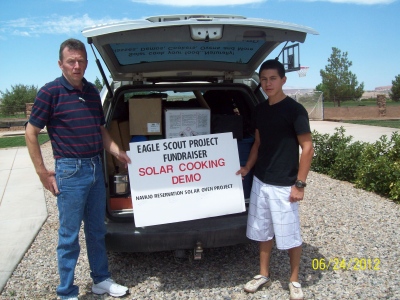
Packed and ready to go to Monument Valley Navajo Reservation on June 24th, 2012
On June 24th we traveled for five hours over to the Monument Valley Navajo Tribal area,
taking a southerly route, traveling through Kanab, Utah and Page,
Arizona passing through Glen Canyon National Recreation Area (Lake
Powell) and through much scenic country along the way. We were in the
high desert throughout the trip with nice summer temperatures and
spectacular desert vistas all during our time on this project.
We arrived at our lodging unit in Monument Valley at a famous old trading post and tourist lodging site, Goulding Lodge, which had been established in the 1930's and where many a famous actors, such as John Wayne, Clint Eastwood and others, spent their nights while filming some of Hollywood's classic westerns.
Here at Gouldings Lodge we joined up with our associate and program director, Mary Phillips and her friend Dana, of ADOPT-A-NATIVE ELDER,
the Park City, Utah based organization that was spearheading the
program and which worked for many years giving vital monetary, physical
and personal assistance to elderly Navajo Natives throughout the Utah
and Arizona Reservation.
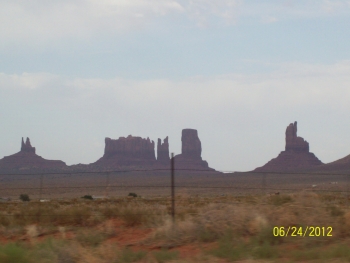
Arriving in the outskirts of Monument Valley, Utah
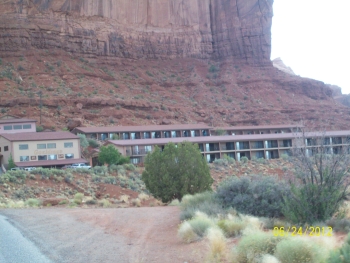
Goulding Lodge in Monument Valley where we stayed during our time there
As soon as we acquired our rooms we
loaded all of the clothing, food, and cooker donations into the living
room area of the unit in order to sort and take inventory so that we
would have all ready for the families each day that we were scheduled to
visit and teach each one. We sure had a lot of goods and items that
would be distributed over the next few days.
Our first day of
teaching was on Monday and we were scheduled to work with a family
located across dirt roads about 16 miles from where we were staying.
Most of the homes are spread out across the reservation with many miles
in between each, making for far distant neighbors and infrequent contact
with others.
When we arrived the family was nowhere to be found and
we later learned that they had needed to go and attend to an aged and
sick family member for a few days, and so we decided that we would move
our schedule up by one day and visit the family/person that we were
scheduled to work with the following day.
Our guide/interpreter and liaison Bessie Holiday,
A Navajo Nation Employee who oversees the senior center for that area,
had previously selected and arranged for the families we were to meet
with and she made the decision to move the schedule in this manner so
that we could take maximum advantage of our time on the reservation.
We
went back 16 miles towards our lodging and continued past our place on
the same road to the west about one mile and were soon at the house of
our first recipient, a Navajo Lady by the name of Helen, a sister of Bessie, who looked to be about sixty years old.
She greeted us very amicably and introduced us also to her other sister Lucy, who was accompanied by her eleven year old grandson, Justin.
After
introductions we quickly set up our tables, solar cookers and other
wares and began to instruct them on the basics of setting up and using
the solar cookers, the two Global Sun Ovens that we had brought for
them, as well as the Solar Burner Parabolic Cooker.
Our menu for that day was to be cinnamon/sweet rolls which we put in right away and hamburgers/hotdogs and corn on the cob along with some hard boiled eggs.
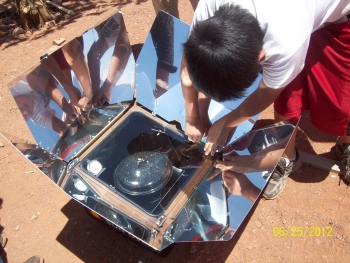
First day teaching solar cooking with brand new Sun Ovens. Letting the students learn hands-on.
Explaining to our guide how the Solar Burner parabolic cooker works
We
wanted to show them how the solar cookers could cook a variety of items
in various ways and so we felt that hard boiled (baked) eggs both in
and out of water would capture their attention among the other things we
had planned.
We set up the parabolic cooker while the sweet rolls
were baking in the two sun ovens and started grilling/frying up burgers
and hot dogs, which were cooked within ten minutes from the time we
started them in our cast iron frying pan on the Solar Burner.
The
sweet rolls browned up nicely in abut forty minutes and we let them cool
off a bit and then covered them in icing, and before we could even
serve the burgers and hot dogs everyone had consumed the majority of the
sweet rolls.
Before we started eating lunch at 11:30 we had two marinated whole chickens
into the Sun Ovens, inside of the round covered roasters where they
would cook for the next four and a half hours for our dinner later that
evening.
We boiled up some eggs on the parabolic cooker and also
set a couple of eggs inside of the Sun Oven to bake while we shucked the
corn on the cob.
We sat around in the shade of the carport and
conversed about a variety of topics interspersed continually with
instruction on solar cooking and how to most effectively use the solar
cookers.
We had the participants assist us with the cooking and
keeping an eye on the various cookers throughout the remainder of the
afternoon, especially when a steady afternoon breeze kicked up and
caused us some consternation with continual threats of upended solar
cookers.
We used bricks to brace the Sun Ovens on each side and back
of the cookers and this helped to keep them upright and stable
throughout the remainder of the day with no mishaps to speak of.
By
about 2:30 we had intermittent billowy clouds the rest of the day that
came and went; sometimes leaving the cookers in a shadow for as much as
five to ten minutes, and then the sunshine would pop back out and raise
the temperature of the ovens right back up again. The temperature in
each oven hovered between a low of 250 to 350 F during the cooking
period.
Class Participants of our solar cooking demonstration, we had lots of good food to eat for lunch and dinner
While we were conversing and telling stories amongst the
group I broke out the popcorn and we quickly cooked up a big pan of
popcorn cooked in olive oil, which was a big hit with our
students/participants.
Every time we successfully solar cooked the
various food items on our menu it was greeted with enthusiasm and
amazement at how well all the food turned out by using just the power of
the sun to cook it.
Bessie, our Navajo guide/liaison, had been very
skeptical about solar cooking when she first heard about the concept.
She had never seen or heard of the such a thing and she had in her mind
the idea of food that had been left on a table in the sun, which she had
experienced before, stating that "it did not taste very good at all".
After
she was able to try all of our great solar cooked fare, she became a
big advocate of the concept of solar cooking and she took many
opportunities over the next few days to help others understand how it
worked by way of her own explanation of what solar cooking was.
At a half hour before the chicken was finished around 4:30 PM we set the corn-on-the-cob in a big pot of water to cook on the Solar Burner Parabolic Cooker, which took about thirty minutes from start to finish.
Once
we had everything else ready for the meal we pulled the pots with the
chickens out of the Sun Ovens a little after five o'clock and to
everyone's amazement the chickens were nice and browned on top and soft
and moist inside, to the point that the bones pulled right out of the
meat.
Our menu and results that day were very satisfactory, and
the recipients were very content with the food we ate, and they were
quite impressed with the abilities of each of the solar cookers used to
cook our meals.
This was the whole purpose of our project on the
Navajo Reservation, which was to give the people some hands on
experience and various opportunities to cook an assortment of foods on
different solar cookers under varying conditions.
After we
finished cleaning up it was decided we would return to this same home,
that of Helen, and we would cook another meal for her and other invited
guests, anyone who would like to come and learn about solar cooking.
Back
at our hotel room we analyzed the results of the day and all of us felt
that it had gone very well and that the recipients had learned much,
and so we were excited for the next day's opportunity to cook and
instruct.
The second day of our project produced very similar and
satisfactory results with our solar cooking as well, even though we had
to battle stronger winds and more intermittent cloudiness through out
the day. Nevertheless we had enough sunshine and were able to cook all
of our food without any serious mishaps other than micro bursts of wind
that really shook and moved the solar cookers. Today though we did a mutton stew with potatoes, onions, carrots and green beans on the side for our dinner.
This second day also allowed us to present our solar cookers and instruction to a new couple by the name of Herman and Jenene,
both of whom looked to be in their mid to late fifties and who showed
much interest and excitement for the opportunity to be able to acquire a
solar oven and a solar parabolic cooker for their own use.
This
couple were very entrepreneurial minded small business owners and made
their living principally selling homemade foods at various places on
the reservation. They cooked and sold fresh burritos from their
little stand, and they were already imagining how they could use the
solar cookers to be able to cook the same, as well as offer fry bread
cooked on the Solar Parabolic.
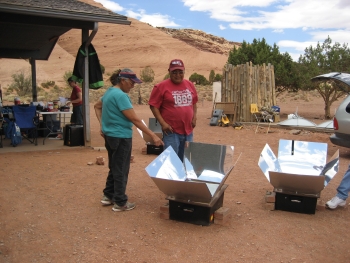
Second day participants of our Solar Cooking Project learning about the Sun Ovens
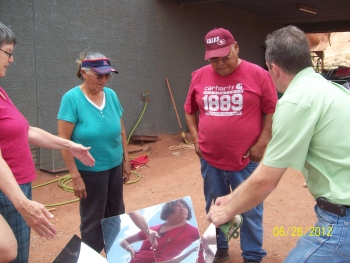
Learning the basics (easy) of Solar Cooking
All of the previous day's
participants were at Helen's house again and so they got a double dose
of instruction, which we felt was good because they would be able to
become more familiar and comfortable with the concept of solar cooking.
After lunch we again sat around conversing and eating more solar cooked popcorn, which is always a favorite with everyone.
Learning about the Solar Burner Parabolic cooker
Popcorn on a Parabolic being cooked in a cast iron frying pan
Our third day of the solar cooker project was spent out at a home near a couple of the Famous Monument Valley Landmarks that appear in most of the photos that one would see in tourism brochures, they are called the west mitten and east mitten.
This was the home of Bessie's Daughter, Ophelia and Son-in-law, Carlton and their small children, along with two other couples and Carlton's Mother.
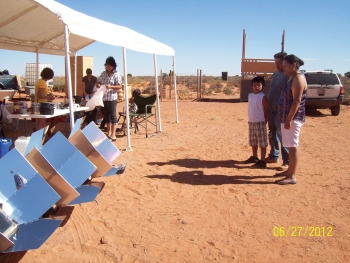
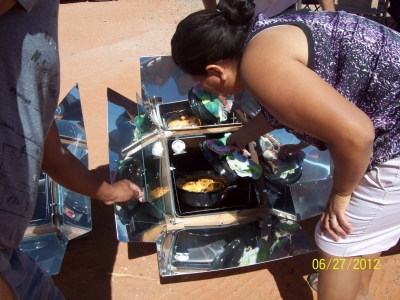
This day we decided to cook everything we had left, including blueberry quick bread, more sweet rolls, hard boiled eggs, green beans and the last four whole chickens for dinner. Our lunch consisted of the same as before, Burgers, Hotdogs and sweet rolls except that we cooked for quite a few more people this day.
The
baked goods were finished before lunch was even begun, and so we
quickly put the chickens and the green beans into the already preheated
Sun Ovens, of which we now had four functioning units available, so that
we could assure that we would have sufficient time to cook everything
well.
After all was set and cooking, we again made solar cooked popcorn
and conversed for a while, and then were invited to take a little tour
about a mile away to see some hieroglyphs which occupied about an hour
of our time.
Carlton kept an eye on the solar ovens while we were
gone and did a good job of focusing them based on the instruction they
had receive earlier that morning.
As the day progressed, we could see
the clouds again accumulating on the horizon and we knew that by late
afternoon we would have some challenges with our solar cooking. Luckily
though the clouds did not rapidly gather over where we were and it was
about 5:00 PM before they thickened enough to block the sunlight. By
5:00 PM though we had already started to eat and so we were not affected
by their presence.
Another couple attended this day, and the husband whose name was Roger, was very open to,
and intrigued by, the concept of solar cooking. Roger was very
mechanically inclined, like Herman, and he was so excited to find out
that he was going to be a recipient of a Solar Burner Parabolic cooker
as well as a Sun Oven. He grabbed his power tools out of his truck in
order to help my boy, Josh, to put the parabolic together, which they
did in very short order.
Roger spent quite a bit of time conversing
with me as I cooked on the parabolic and gave him instruction on how to
use it most effectively.
He already understood the theories and
concepts behind solar concentration and so it was not too difficult for
him to grasp any of what I was teaching; and he had a mechanically
oriented mind as well.
Roger had to leave for work just after our
sweet rool, burger and hot dog lunch so he did not get to have dinner
with us, but he was happy to leave with his parabolic cooker and his
wife would then bring home their Global Sun Oven after the chickens were
cooked.
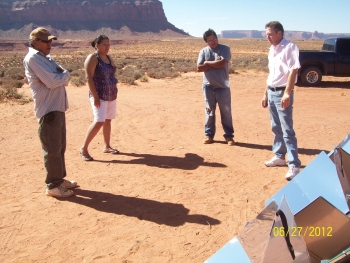
There was another couple that also attended, who were
not able to receive a solar cooker at the time because we had run out of
solar cookers by then.
We had planned and budgeted for six Sun Ovens
and three parabolic cookers (I brought a fourth, just in case, which
went to Roger) and in the end we had to divide the cookers amongst more
people. So, rather than each family receiving two Sun Ovens, each ended
up with one and certain families or individuals received the parabolic
cookers; those who seemed most comfortable with and inclined to use
them.
---sidebar--- We are looking into raising more funds
to send more solar ovens down at a future date for those who could not
receive them at this time.
By then we hope that there will be others
who will have had a chance to learn from those who now have solar
cookers and will be anxious and ready to receive them when we do send
more. ---
At the end of the day when we returned to our
hotel room we were worn out, but very happy and content with the results
of our day and with how all had transpired over the last few days. All
of us, including the recipients, felt that all of our efforts had been
very successful and very well received.
There is so much more I
could share about this trip and project, but I dare not write any more
because I would end up with a small novel that would take up many pages
of our site and too much of my time and your time as well.
We do
plan on keeping our site visitors appraised of our work on the
reservation and the progress of those who are now using the solar
cookers, so stay tuned for upcoming narratives and short stories.
_____________________________________________________________________________
Update:
20 February 2014
We just heard from Mary Phillips of Adopt-a-Native-Elder that the solar cookers are still being used by most of the recipients, if not all, and the are getting quite a bit of use from the.
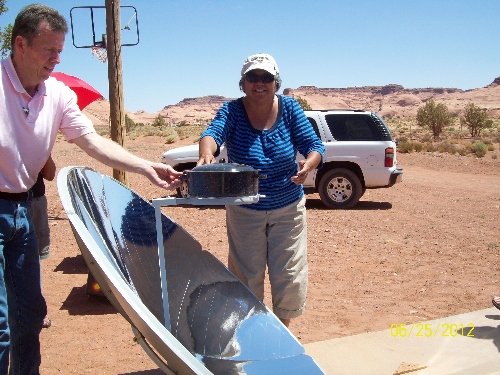
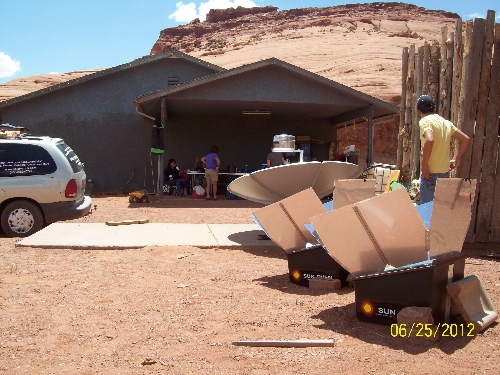
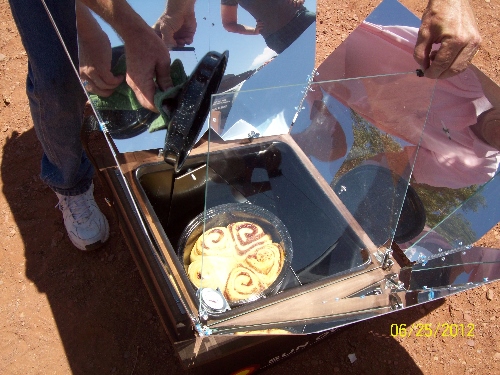
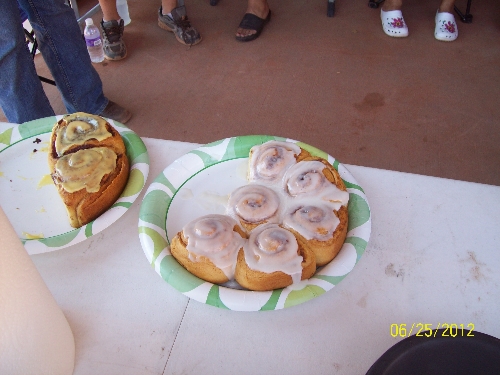
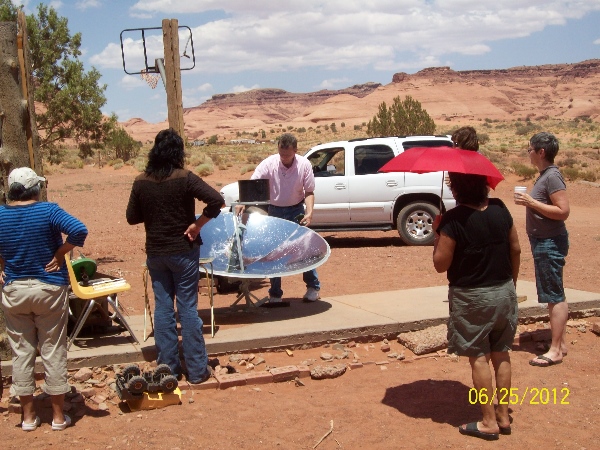
Return from Navajo Reservation Solar Cooking Project, back to Solar Cooking Initiatives
Share with all of us your Solar Cooking Experiences, Events and Photos
We would like to know all about your Solar Cooking Experiences; successes and failures as well as the cookers you use, whether homemade or manufactured.
Share as much detail as you would like...even submit photos as well.
SOLAR COOKER CATEGORIES
Panel Cookers
Box Cookers
Parabolic Cooker
Evacuated Cookers
Accessories
Discontinued CookersNew Financing Options available for purchase of Solar Cookers
Find out more about how, where and when to solar cook.
How Solar Cooking Works
When to Solar Cook
Where you can Solar Cook
Winter Solar Cooking
Emergency Preparedness Solar Cooking
Canning with a Solar Cooker
Tips for Solar Cooking
Frequently Asked Solar Cooking Questions
Solar Cooking Recipes
Solar Cooking Videos

